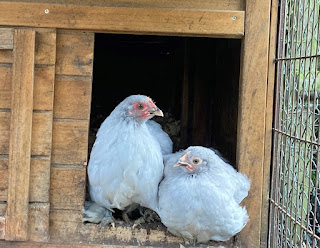I cut out down the blackberry canes today and tied in this year's new ones. Another winter job completed.
Blackberry
picking in late summer is an annual ritual for many. It is a pleasant way to
spend a sunny afternoon in the outdoors and there is a certain satisfaction in
foraging food for free. Perhaps you have a favourite spot where you can usually
be sure of good pickings. Blackberry plants are prodigious growers and
abundant fruiters; there is bound to
be somewhere to pick them not too far off.
Is it worth, therefore, growing blackberries at home?
I would say yes, but only if you have growing space to spare — there are
probably other berry fruits that come higher up the priority list if space is
limited.
There are a number of benefits in growing your own
blackberries. Modern cultivated varieties produce larger fruits, they can
thrive in all but shallow chalky soils and they tolerate shade pretty well.
Perhaps the biggest advantage of home
grown blackberries is that there are now several thornless varieties available
which can save your hands and arms from scratches and, if you train them, this
makes the berries much more accessible compared to the inevitable over-stretching for a choice fruit in a wild
blackberry clump. Blackberry bushes are also very attractive to bees and as
they flower relatively late compared to most other berry fruits (May onwards)
this is another good reason for growing them.
Although not so vigorous as wild blackberry bushes,
cultivars can readily grow multiple eight feet (2.4m) stems in a summer season
and can potentially take up a lot of space. One plant is probably enough for
most people, and being self-fertile a
solitary plant will fruit perfectly well.
Most blackberry cultivars produce the majority of
their fruit on year old canes, so the new canes thrown up in one summer need to
be tied in ready for the following summer and the old canes which have fruited
should be pruned out at ground level. This is what I was doing today.
As they are vigorous
plants it is important to keep on top of the pruning and training otherwise you will end
up with a demoralising thicket. We have three plants, planted in a row six feet
apart. The support structure consists of four sturdy 7’ posts along the
row with horizontal strands of wire set 12” apart. The canes are tied to
the support wires in an arc like fashion when the canes are still supple enough
to bend. Any weak canes are cut out as
are any growing away from the line and finally any excess canes. As the new
canes are tied in they can be evenly spaced along the support structure. I’ve
used free standing posts but the same approach against a wall or fence will be
fine too.
There are not too many disease or pest issues with
blackberry plants. They are tough reliable plants. One thing to look out for,
though, is the occasional stem growing out from the roots which have reverted
to type and are extremely prickly (and
so readily identifiable). These need to
be removed as soon as they are spotted otherwise they will eventually develop
into a wild bramble bush. I wear thick gloves and pull them out so that they
are detached at source. If they are just cut with secateurs they are likely to
re-grow.
There are lots of things blackberries can be used for
in the kitchen including desserts and cordials. But if you have a surplus they can be frozen
on baking trays and then bagged up for future use. They retain their shape and
structure very well when defrosted. We had a big crop this year so have plenty stashed away in the freezer.
 |
| Blackberries with grapes on the side |


























